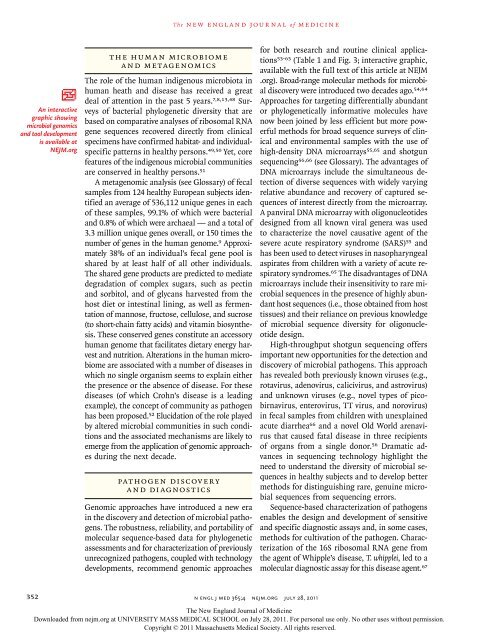Microbial Genomics and Infectious Diseases - Evernote
Microbial Genomics and Infectious Diseases - Evernote
Microbial Genomics and Infectious Diseases - Evernote
Create successful ePaper yourself
Turn your PDF publications into a flip-book with our unique Google optimized e-Paper software.
An interactive<br />
graphic showing<br />
microbial genomics<br />
<strong>and</strong> tool development<br />
is available at<br />
NEJM.org<br />
352<br />
The Hum a n Microbiome<br />
a nd Me tagenomics<br />
The role of the human indigenous microbiota in<br />
human heath <strong>and</strong> disease has received a great<br />
deal of attention in the past 5 years. 7,8,13,48 Surveys<br />
of bacterial phylogenetic diversity that are<br />
based on comparative analyses of ribosomal RNA<br />
gene sequences recovered directly from clinical<br />
specimens have confirmed habitat- <strong>and</strong> individualspecific<br />
patterns in healthy persons. 49,50 Yet, core<br />
features of the indigenous microbial communities<br />
are conserved in healthy persons. 51<br />
A metagenomic analysis (see Glossary) of fecal<br />
samples from 124 healthy European subjects identified<br />
an average of 536,112 unique genes in each<br />
of these samples, 99.1% of which were bacterial<br />
<strong>and</strong> 0.8% of which were archaeal — <strong>and</strong> a total of<br />
3.3 million unique genes overall, or 150 times the<br />
number of genes in the human genome. 9 Approximately<br />
38% of an individual’s fecal gene pool is<br />
shared by at least half of all other individuals.<br />
The shared gene products are predicted to mediate<br />
degradation of complex sugars, such as pectin<br />
<strong>and</strong> sorbitol, <strong>and</strong> of glycans harvested from the<br />
host diet or intestinal lining, as well as fermentation<br />
of mannose, fructose, cellulose, <strong>and</strong> sucrose<br />
(to short-chain fatty acids) <strong>and</strong> vitamin biosynthesis.<br />
These conserved genes constitute an accessory<br />
human genome that facilitates dietary energy harvest<br />
<strong>and</strong> nutrition. Alterations in the human microbiome<br />
are associated with a number of diseases in<br />
which no single organism seems to explain either<br />
the presence or the absence of disease. For these<br />
diseases (of which Crohn’s disease is a leading<br />
example), the concept of community as pathogen<br />
has been proposed. 52 Elucidation of the role played<br />
by altered microbial communities in such conditions<br />
<strong>and</strong> the associated mechanisms are likely to<br />
emerge from the application of genomic approaches<br />
during the next decade.<br />
Patho gen Discov er y<br />
a nd Di agnos tics<br />
Genomic approaches have introduced a new era<br />
in the discovery <strong>and</strong> detection of microbial pathogens.<br />
The robustness, reliability, <strong>and</strong> portability of<br />
molecular sequence-based data for phylogenetic<br />
assessments <strong>and</strong> for characterization of previously<br />
unrecognized pathogens, coupled with technology<br />
developments, recommend genomic approaches<br />
T h e n e w e ngl a nd j o u r na l o f m e dic i n e<br />
n engl j med 365;4 nejm.org july 28, 2011<br />
for both research <strong>and</strong> routine clinical applications<br />
53-63 (Table 1 <strong>and</strong> Fig. 3; interactive graphic,<br />
available with the full text of this article at NEJM<br />
.org). Broad-range molecular methods for microbial<br />
discovery were introduced two decades ago. 54,64<br />
Approaches for targeting differentially abundant<br />
or phylogenetically informative molecules have<br />
now been joined by less efficient but more powerful<br />
methods for broad sequence surveys of clinical<br />
<strong>and</strong> environmental samples with the use of<br />
high-density DNA microarrays 55,65 <strong>and</strong> shotgun<br />
sequencing 56,66 (see Glossary). The advantages of<br />
DNA microarrays include the simultaneous detection<br />
of diverse sequences with widely varying<br />
relative abundance <strong>and</strong> recovery of captured sequences<br />
of interest directly from the microarray.<br />
A panviral DNA microarray with oligonucleotides<br />
designed from all known viral genera was used<br />
to characterize the novel causative agent of the<br />
severe acute respiratory syndrome (SARS) 55 <strong>and</strong><br />
has been used to detect viruses in nasopharyngeal<br />
aspirates from children with a variety of acute respiratory<br />
syndromes. 65 The disadvantages of DNA<br />
microarrays include their insensitivity to rare microbial<br />
sequences in the presence of highly abundant<br />
host sequences (i.e., those obtained from host<br />
tissues) <strong>and</strong> their reliance on previous knowledge<br />
of microbial sequence diversity for oligonucleotide<br />
design.<br />
High-throughput shotgun sequencing offers<br />
important new opportunities for the detection <strong>and</strong><br />
discovery of microbial pathogens. This approach<br />
has revealed both previously known viruses (e.g.,<br />
rotavirus, adenovirus, calicivirus, <strong>and</strong> astrovirus)<br />
<strong>and</strong> unknown viruses (e.g., novel types of picobirnavirus,<br />
enterovirus, TT virus, <strong>and</strong> norovirus)<br />
in fecal samples from children with unexplained<br />
acute diarrhea 66 <strong>and</strong> a novel Old World arenavirus<br />
that caused fatal disease in three recipients<br />
of organs from a single donor. 56 Dramatic advances<br />
in sequencing technology highlight the<br />
need to underst<strong>and</strong> the diversity of microbial sequences<br />
in healthy subjects <strong>and</strong> to develop better<br />
methods for distinguishing rare, genuine microbial<br />
sequences from sequencing errors.<br />
Sequence-based characterization of pathogens<br />
enables the design <strong>and</strong> development of sensitive<br />
<strong>and</strong> specific diagnostic assays <strong>and</strong>, in some cases,<br />
methods for cultivation of the pathogen. Characterization<br />
of the 16S ribosomal RNA gene from<br />
the agent of Whipple’s disease, T. whipplei, led to a<br />
molecular diagnostic assay for this disease agent. 67<br />
The New Engl<strong>and</strong> Journal of Medicine<br />
Downloaded from nejm.org at UNIVERSITY MASS MEDICAL SCHOOL on July 28, 2011. For personal use only. No other uses without permission.<br />
Copyright © 2011 Massachusetts Medical Society. All rights reserved.
















